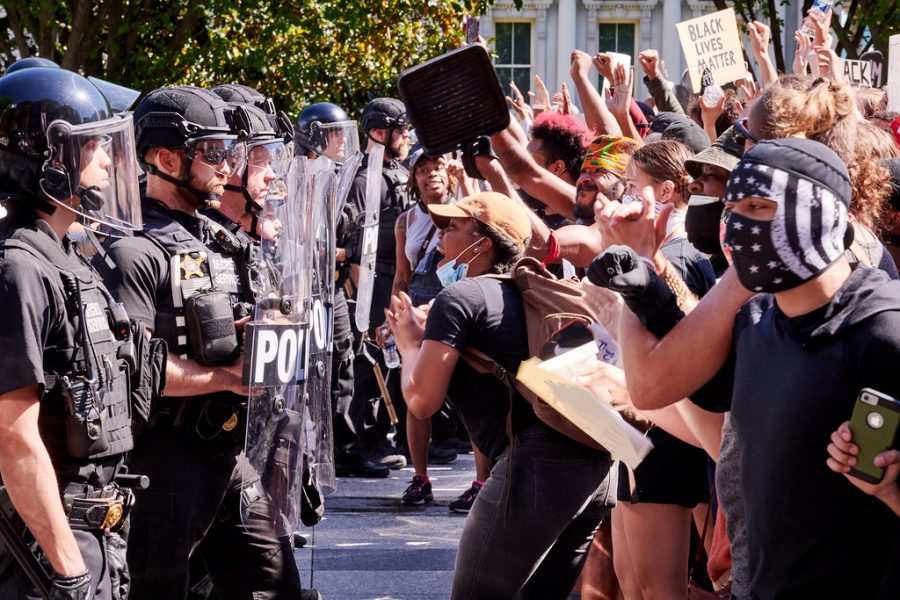Two Officer Involved Shootings Within Minnesota Lead To Civil Uproar
As The Case Against Former Officer Derek Chauvin Closes, Minnesota Reels With The Death Of Duante Wright
“George Floyd protest by the White House (5/30/20)” by Geoff Livingston is licensed under CC BY-NC-ND 2.0
April 26, 2021
Minnesota: A state divided after a series of deadly shootings involving police officers against members of the Black community.
The unrest quickly unraveled after former police officers Derek Chauvin, Thomas Lane, Tou Thao, and J. Kueng responded to a call regarding a possible counterfeit 20 dollar bill circulating at Cup Foods on May 25th.
George Floyd, the man that had presented the store clerk with this bill, was detained by police regarding the transaction. The detention escalated as Floyd was placed onto the ground by Chauvin and was held there for a lengthy duration until he eventually died and was ushered away.
The department delivered a statement that Floyd died as a result of a medical incident but was resisting during the time of his arrest justifying Chauvin’s actions.
However, videos flooded the internet capturing what appeared to be an irritated Chauvin pinning Floyd’s neck with his knee. Floyd repeatedly stated that he could not breathe as a crowd formed around the officer stating that he was using excessive force.
“I did call the police, on the police. Because I believed I witnesses a murder.” Mixed martial arts fighter and witness Donald Williams said.
The videos were each captured from various perspectives, some of which was street footage others from civilians concerned about the use of force. It has now been documented that the total length at which Floyd was pinned down was over nine minutes, a minute more than what was initially described.
“On May 25th, of 2020, Mr. Dereck Chauvin betrayed this badge, when he used excessive and unreasonable force upon the body of Mr. George Floyd.” Prosecutor Jerry Blackwell said in his opening statement.
Since the video was released, a campaign of protests in association with the Black Lives Matter (BLM) movement spread throughout the community. Some of which called for Chauvin to be fired and arrested for murder.
Shortly after, another movement known as Defund the Police arose within these protests. The interpretation of this movement for some was to reallocate funding provided to police departments. For others, the movement became synonymous with abolishing the police system altogether.
“Different from abolishing and starting anew, defunding police highlights fiscal responsibility, advocates for a market-driven approach to taxpayer money, and has some potential benefits that will reduce police violence and crime.” Dr. Rashan Ray wrote.
Yet within these peaceful protests, a sequence of violent riots and lootings spurred throughout the country in protest of police brutality. Citizens were left polarized regarding the looting, with arguments claiming that these acts of theft were justified. Others felt that they disproportionately targeted individuals outside of the police department.
“Looting strikes at the heart of property, of whiteness and of the police. It gets to the very root of the way those three things are interconnected. And also it provides people with an imaginative sense of freedom and pleasure and helps them imagine a world that could be.” Author of, In Defense of Looting, Vicky Osterweil said in an NPR interview.”
Facing public uproar and the indisputable death of Floyd, Chauvin was promptly charged with third degree murder, but the charge was revised to second degree murder on June 3rd. While third and second degree murder are both serious charges, the consequences for each charge vary.
“Whoever, without intent to effect the death of any person, causes the death of another by perpetrating an act eminently dangerous to others and evincing a depraved mind, without regard for human life, is guilty of murder in the third degree and may be sentenced to imprisonment for not more than 25 years.” The 2020 Minnesota Statutes writes.
Comparatively, under the second subdivision of the Minnesota statute allocated to unintentional deaths states that “Whoever does either of the following is guilty of unintentional murder in the second degree and may be sentenced to imprisonment for not more than 40 years”
The second option specifically details deaths that are without intent, but occur concurrently with intentional bodily harm.
An initial set of protests in Minnesota resurfaced as Chauvin’s trial began with opening statements on March 29th. Key witnesses and expert testimonies were brought by both the prosecution and defense; the prosecution arguing that it was an excessive use of force, the latter arguing that it was reasonable.
“So I see his arm position in the picture that’s posted, that a compliant person would have both their hands in the small of their back and just be resting comfortably, versus like he’s still moving around.” Private consultant and expert on use of force for the defense, Barry Brodd stated.
However, after approximately 10 hours of deliberation split between two days, the jury had reached a verdict.
Chauvin’s conviction made headlines and spread across protestors who waited in the streets of Minnesota. Yet, this victory for them was interrupted when another officer involved shooting occurred amidst the trial.
20-year-old Daunte Wright was pulled over by police for a traffic violation. Upon entering his name within the database, they found that Wright had an outstanding warrant. The officers quickly moved to arrest Wright ensuing a scuffle as Wright attempted to flee.
“I can’t accept that — a mistake, that doesn’t even sound right,” he added. “This officer has been on the force for 26 years. I can’t accept that.” Wright’s father, Aubrey Wright stated in an interview with ABC.
During the scuffle, 26 year veteran officer Kim Potter drew her police issued piece and called taser multiple times. However, after discharging the round into Wright, Potter made the sudden discovery that she had not drawn her taser.
“As you can hear, the officer, while struggling with Mr. Wright yells ‘Taser! Taser!’ several times. That is part of the officer’s training prior to deploying a Taser, which is a less lethal device,” Chief Tom Gannon said. “As I watch the video and listen to the officer’s commands, it is my belief that the officer had the intention to deploy their Taser, but instead shot Mr. Wright with a single bullet.”
The shooting took place only several miles away from where Floyd’s died. The Twin Cities erupted once more in protests and riots over another killing involving an officer. The police force rolled out a set of dispersing tools including tear gas after an officer was struck in the head with a brick.
The protests and riots lasted for several days with the crowd cheering “Daunte Wright” advocating for justice to be brought for Wright and for the police to be held accountable for using excessive force.
Some scientists argue however, that this type of mistake can happen while an officer is on duty, it has been noted as the “slip and capture” theory.
“Bill Lewinski, an expert on police psychology and founder of the Force Science Institute in Mankato, Minnesota, has used the phrase “slip and capture” errors to describe the phenomenon. Lewinski, who has testified on behalf of police, has said officers sometimes perform the direct opposite of their intended actions under stress – their actions “slip” and are “captured” by a stronger response. He notes that officers train far more often on drawing and firing their handguns than they do on their stun guns.” The Associated Press released in their article explaining the theory.
Other scientists disagree about whether or not this is the true cause for the mistake, others believe Potter used excessive force intentionally. However, these incidents have been documented in the past by other officers, leading to several untimely deaths.



